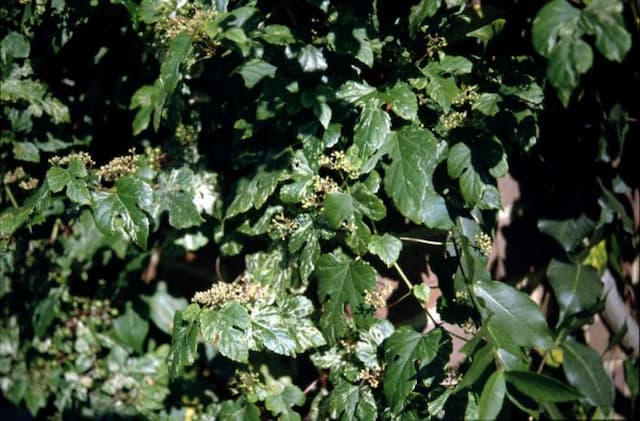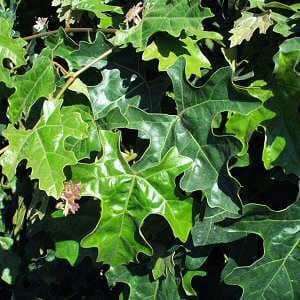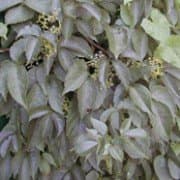Orion grape Vitis 'Orion' (O/w)

ABOUT
Vitis 'Orion', commonly known as the Orion grape, is a cultivar of grape that is valued for both its ornamental qualities and its fruit production. This plant is typically characterized by its climbing growth habit, often requiring support such as a trellis or fence to ascend upon. The leaves of the Orion grape are broad and lobed, with a lush green color that can turn to attractive shades in the fall, depending on environmental conditions. The foliage offers a dense and leafy presence that can provide ample shade in garden settings. The Orion grape is particularly noted for the clusters of fruit it produces. The grapes themselves are usually round and can range in color. The skin of the grapes is smooth, with a waxy layer that can give them a subtle shine. Beneath the skin, the flesh of the grapes is juicy and sweet, making them popular for eating fresh as well as for making wines and jellies. During the blooming period, the plant sports tiny flowers that are generally inconspicuous compared to its lush foliage and vibrant fruit clusters. These flowers are important for pollination, leading to the development of the grapes that hang attractively from the vine in bunches.
About this plant
 Names
NamesFamily
Vitaceae
Synonyms
Orion Grape
Common names
Vitis 'Orion'
 Toxicity
ToxicityTo humans
The grapevine is not considered toxic to humans. However, all parts of the plant, except for the ripe grape berries, contain varying amounts of substances that can cause mild stomach upset if ingested in large quantities. Consumption of large amounts of grape leaves or stems is not common, and therefore poisoning is rare.
To pets
Grapes can be highly toxic to dogs and cats. The exact substance that causes toxicity is unknown, but ingestion can lead to acute kidney failure. Symptoms of grape poisoning in pets can include vomiting, diarrhea, lethargy, abdominal pain, decreased urine production, and sudden kidney failure. Even small amounts can be potentially dangerous, so prompt veterinary attention is crucial if a pet has consumed grapes.
 Characteristics
CharacteristicsLife cycle
Perennials
Foliage type
Deciduous
Color of leaves
Green
Flower color
Greenish-yellow
Height
10 feet (3 meters)
Spread
10 feet (3 meters)
Plant type
Climber
Hardiness zones
5
Native area
Cultivar
Benefits
 General Benefits
General Benefits- Ornamental Appeal: Vitis 'Orion', commonly known as grape vine, has attractive foliage and clusters of grapes that enhance the aesthetic of gardens and landscapes.
- Shade Provision: Its dense leaf canopy can create shaded areas in gardens, providing relief from the sun.
- Habitat for Wildlife: It offers habitat and food sources for birds and other wildlife.
- Edible Fruit: The vine produces grapes that can be eaten fresh or used in making wine, jams, and jellies.
- Erosion Control: The root system helps stabilize soil and prevent erosion on slopes or banks.
- Seasonal Interest: Offers a changing visual interest throughout the seasons with new growth in spring, fruit in summer, and autumn foliage color.
- Versatility: Can be trained to grow on various structures like trellises, arbors, and fences, adapting to different garden designs.
- Pollinator Friendly: Flowers attract bees and other pollinators, supporting biodiversity.
- Privacy Screen: When trained on a fence or trellis, it can act as a living screen, providing privacy and reducing noise.
- Craft and Education: Grapevines can be used in crafting (e.g., wreath making) and provide an educational opportunity for teaching about plant growth and fruit development.
 Medical Properties
Medical PropertiesThis plant is not used for medical purposes.
 Air-purifying Qualities
Air-purifying QualitiesThis plant is not specifically known for air purifying qualities.
 Other Uses
Other Uses- As a natural dye: The skins of 'Orion' grapes can be used to produce a natural dye for fabrics, providing shades of blue, purple, or grey, depending on the mordant used.
- In crafts and decorations: Dried vines and grape clusters from the 'Orion' grapevine can be used to create rustic decorations and wreath bases for doors and walls.
- In landscape design: The vine of 'Orion' can be grown on trellises, pergolas, or fences to provide a lush green barrier or privacy screen during the growing season.
- For erosion control: The robust root system of 'Orion' grapevines can help to stabilize slopes and prevent soil erosion in certain landscape situations.
- As a natural glue: The sap from 'Orion' grapevines can be reduced and used as a natural adhesive for paper or other light materials.
- In cooking: The leaves of the 'Orion' grapevine can be used to wrap food, infusing dishes with a subtle grape flavor, such as in the preparation of dolmas.
- As educational tools: 'Orion' vines can be used in school projects to teach children about plant growth, photosynthesis, and the life cycle of plants.
- In winemaking experiments: Amateur winemakers may use 'Orion' grapes to experiment with unique blends and flavors in the creation of homemade wines.
- For composting: Pruned branches and expired grape clusters can be added to compost piles to create nutrient-rich soil for gardening.
- In art: The grape leaves and vines can be pressed and included in botanical art pieces or used as natural motifs in printmaking.
Interesting Facts
 Feng Shui
Feng ShuiThe grapevine is not used in Feng Shui practice.
 Zodiac Sign Compitability
Zodiac Sign CompitabilityThe grapevine is not used in astrology practice.
 Plant Symbolism
Plant Symbolism- Vitality: As a variety of grapevine, Vitis 'Orion' symbolizes vitality due to its vigorous growth and the abundant production of fruit, representing life and abundance.
- Fertility: Grapevines are often associated with fertility, as they can produce fruit for many years, and Vitis 'Orion', with its grape production, carries this symbol of fruitful multiplication.
- Transformation: Grapes undergo a transformation process to become wine, a drink historically associated with various cultural and religious rituals, making Vitis 'Orion' a representation of change and metamorphosis.
- Prosperity: Given that grapevines such as Vitis 'Orion' require care and suitable conditions to thrive, their successful growth and harvest have traditionally been seen as signs of prosperity and good fortune.
- Pleasure: The grape is a source of enjoyment, whether eaten fresh or as wine, thus Vitis 'Orion' embodies pleasure, celebration, and the enjoyment of life's finer things.
- Dionysian Spirit: In mythology, grapes are closely associated with Dionysus, the god of wine and revelry, making grapevines like Vitis 'Orion' emblems of uninhibited energy and ecstatic enjoyment.
 Water
WaterGrapevines like Vitis 'Orion', commonly known as Orion grapes, should be watered deeply about once a week during the growing season, especially if the weather is dry. The amount of water needed will vary based on soil type and climate, but a good rule of thumb is to provide about 1 gallon per vine each week. During the dormant season, watering can be reduced significantly and should only be done if there are prolonged dry periods. It's important not to overwater, as grapevines are prone to root rot in excessively moist conditions. The goal is to maintain evenly moist soil without waterlogging.
 Light
LightOrion grapes require full sun to produce the best fruit. Ideally, they should receive at least 6 to 8 hours of direct sunlight per day. Planting the vines in a spot that gets unobstructed sunlight throughout the day will lead to healthier growth and better fruit yields. Areas with southern exposure are typically preferred to maximize the amount of sunlight the vines receive.
 Temperature
TemperatureThe ideal growing temperature for Orion grapes ranges from 75 to 85 degrees Fahrenheit during the day. They are relatively hardy and can withstand winter temperatures down to around 0 degrees Fahrenheit. However, it is crucial to protect the vines from late spring frosts which can damage new growth. The vines will go dormant in the winter, which helps them survive colder conditions.
 Pruning
PruningGrapevines such as Orion grapes are pruned to maintain their shape, encourage healthy growth, and maximize fruit production. It is best to prune the vines in late winter or early spring before the buds break. Pruning should be done annually to remove old growth and thin out the vine to ensure adequate light and air circulation. Proper pruning involves leaving a few well-spaced canes from the previous year's growth while removing most of the old wood.
 Cleaning
CleaningAs needed
 Soil
SoilThe best soil mix for growing grapevines like the Vitis 'Orion', commonly known as Orion grapes, is well-draining soil with a mixture of loam and sand to prevent waterlogging. Organic matter such as compost or aged manure can be added to improve fertility. The ideal soil pH for Orion grapes should be slightly acidic to neutral, ranging from 5.5 to 7.0.
 Repotting
RepottingOrion grapes, a type of grapevine, typically do not need frequent repotting as they are often planted directly in the ground. If grown in containers, young grapevines may need repotting every 2-3 years to accommodate root growth. Mature grapevines are rarely repotted; instead, soil top-dressing can be used to replenish nutrients.
 Humidity & Misting
Humidity & MistingOrion grapes thrive in typical outdoor humidity levels, which tend to range from 40-60% relative humidity. As grapevines, they are hardy and adaptable to various environmental conditions but perform best when humidity extremes are avoided.
 Suitable locations
Suitable locationsIndoor
Grow Orion grapes indoors with ample light and space.
Outdoor
Plant Orion grapes in full sun, train on a trellis.
Hardiness zone
5-9 USDA
 Life cycle
Life cycleVitis 'Orion', commonly known as grapevine 'Orion', begins its life cycle with seed germination, where the seed establishes roots and shoots under appropriate environmental conditions. The plant then enters the vegetative growth stage, characterized by the development of a strong root system, stems, and leaves, essential for photosynthesis and growth. As the grapevine matures, it enters the flowering stage, where flowers are produced that are pollinated and fertilized, leading to fruit set. Following pollination, the fruit development stage occurs, during which the grapes grow, accumulate sugars, and undergo veraison, changing color as they ripen. Upon reaching full maturity, the grapes are harvested, and this marks the culmination of the annual growth cycle for cultivated grapevines. Lastly, in the post-harvest phase, the grapevine enters dormancy during the colder months to conserve energy for the next growing season.
 Propogation
PropogationPropogation time
Spring-Early Summer
Vitis 'Orion', commonly known as Orion grape, is a variety of grapevine that can be propagated most effectively via hardwood cuttings. This method is popular because it utilizes the dormant period of the grapevine to encourage new plant growth from mature, woody stems. Hardwood cutting propagation typically takes place during the late fall after leaf drop or early winter, before the grapevine becomes active again in spring. Cuttings are taken from healthy, mature canes of the previous year's growth, ideally measuring about 12 to 18 inches (30 to 45 centimeters) in length with a pencil-thickness diameter. Each cutting should have at least three buds and the bottom end of the cutting is often dipped in a rooting hormone to encourage root growth. The cuttings are then planted in well-drained soil and kept moist until they begin to root and eventually grown into new grapevines.







![Grape [Claret Cloak]](/_next/image?url=https%3A%2F%2Fplants-admin.emdemapps.com%2Fimages%2Fplants%2F%2Fimages%2F604b602abe2f8.png&w=640&q=75)

